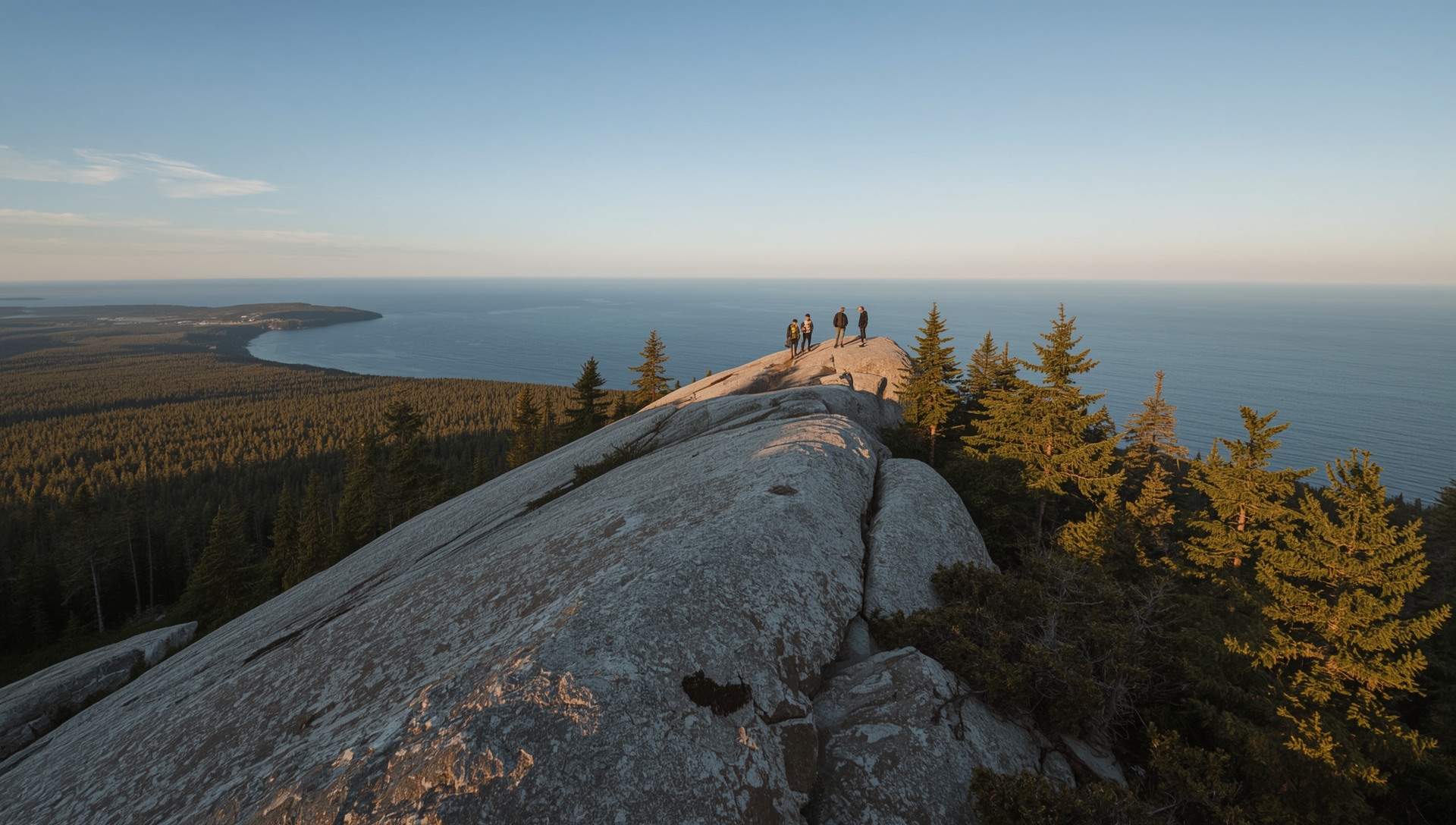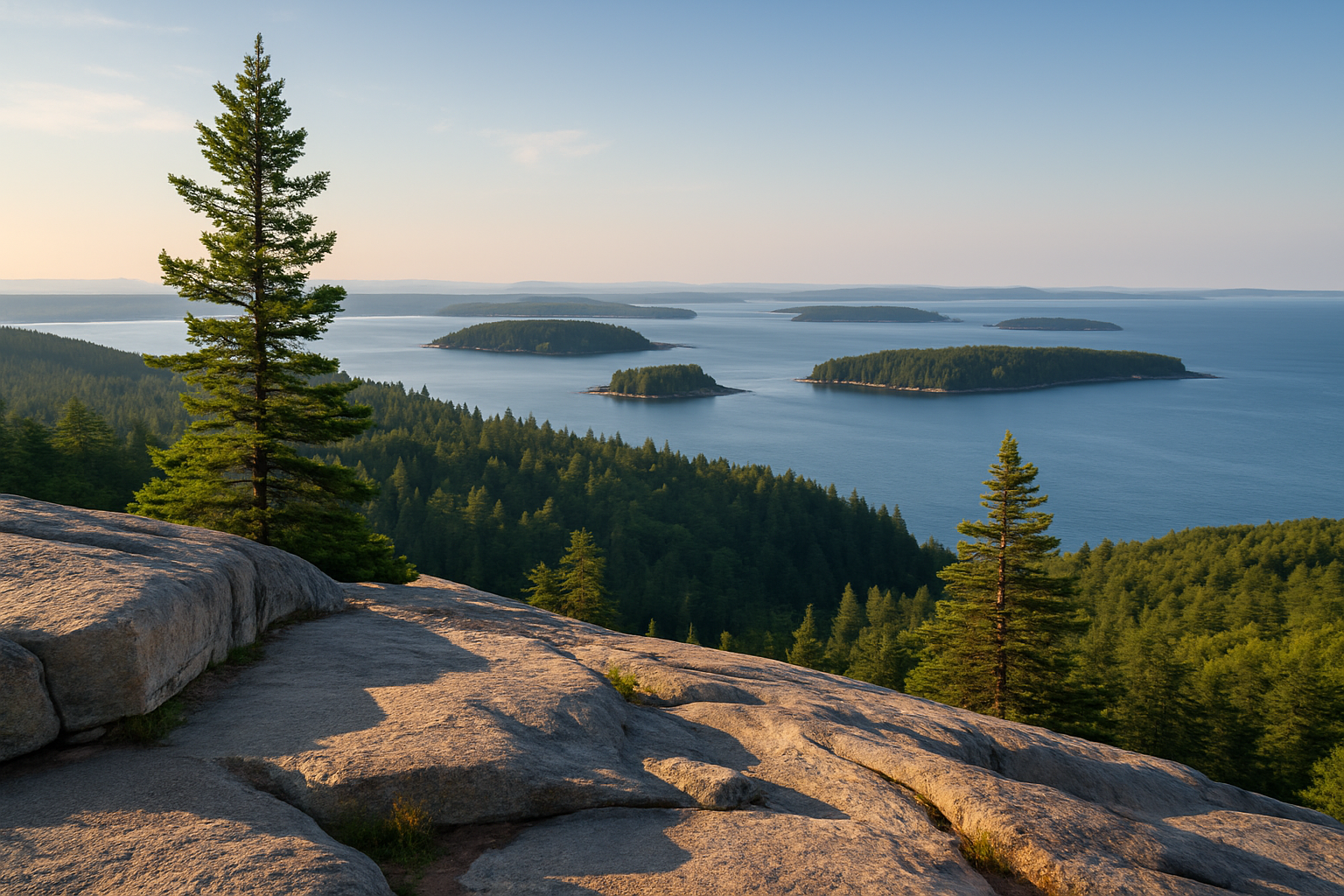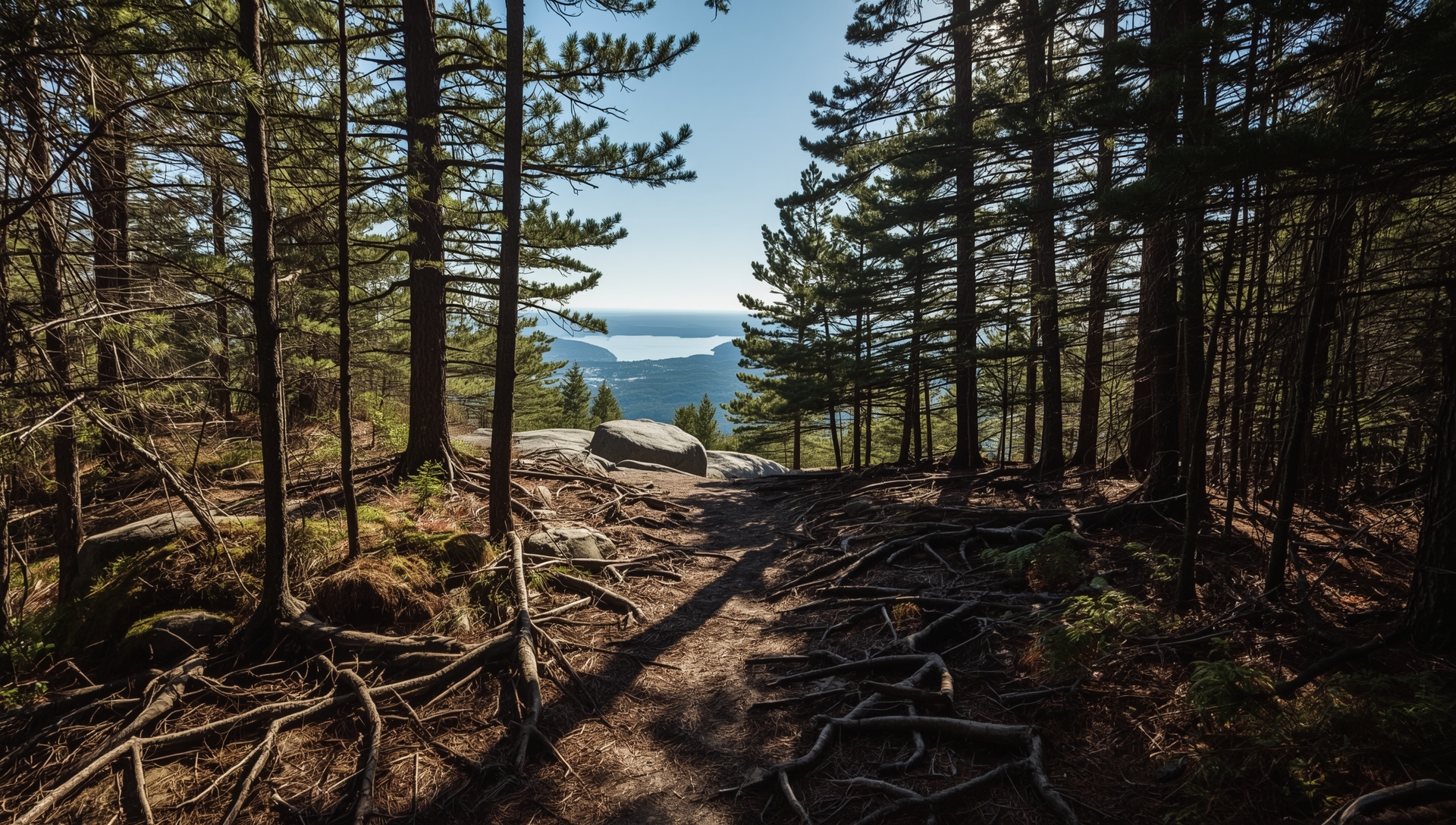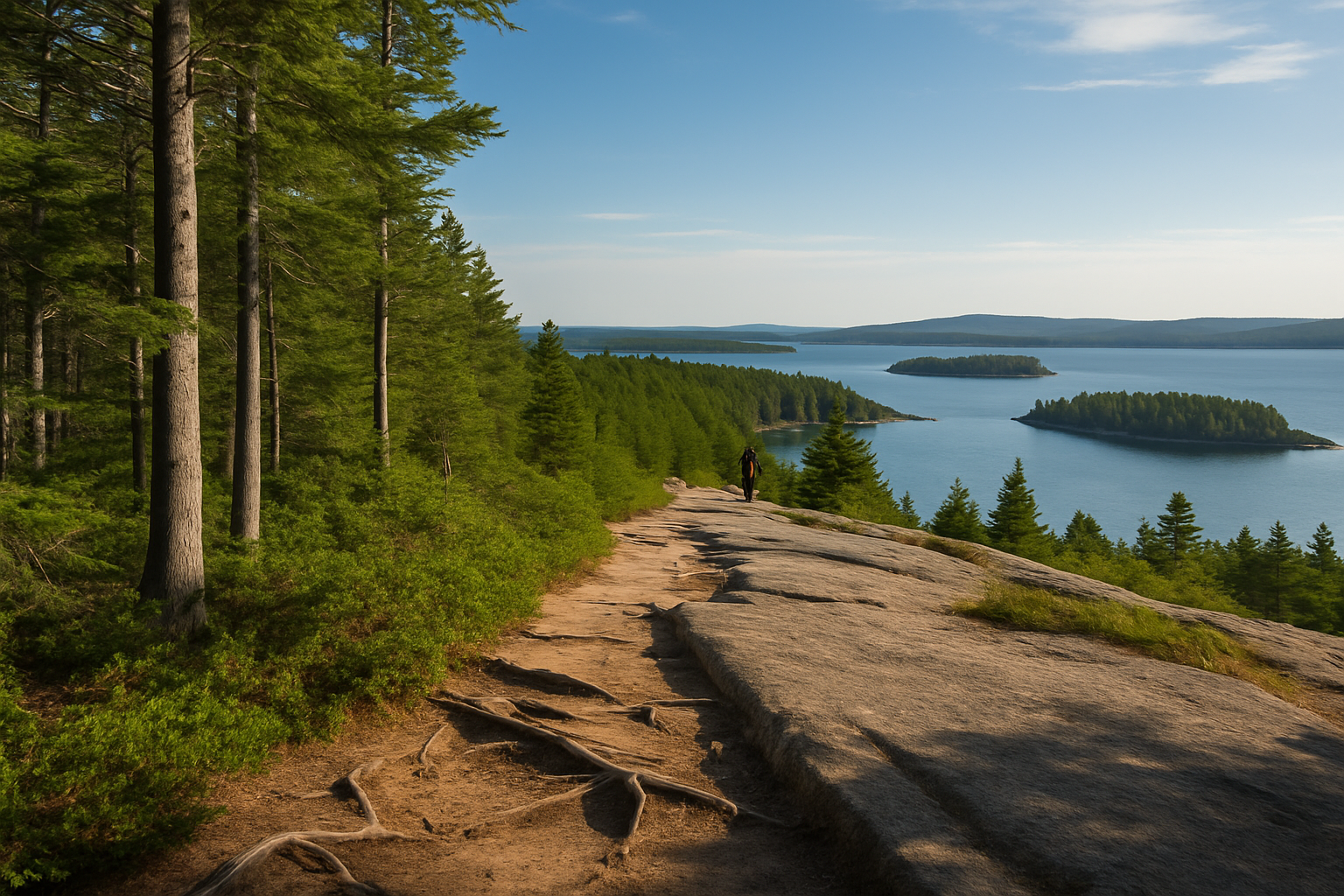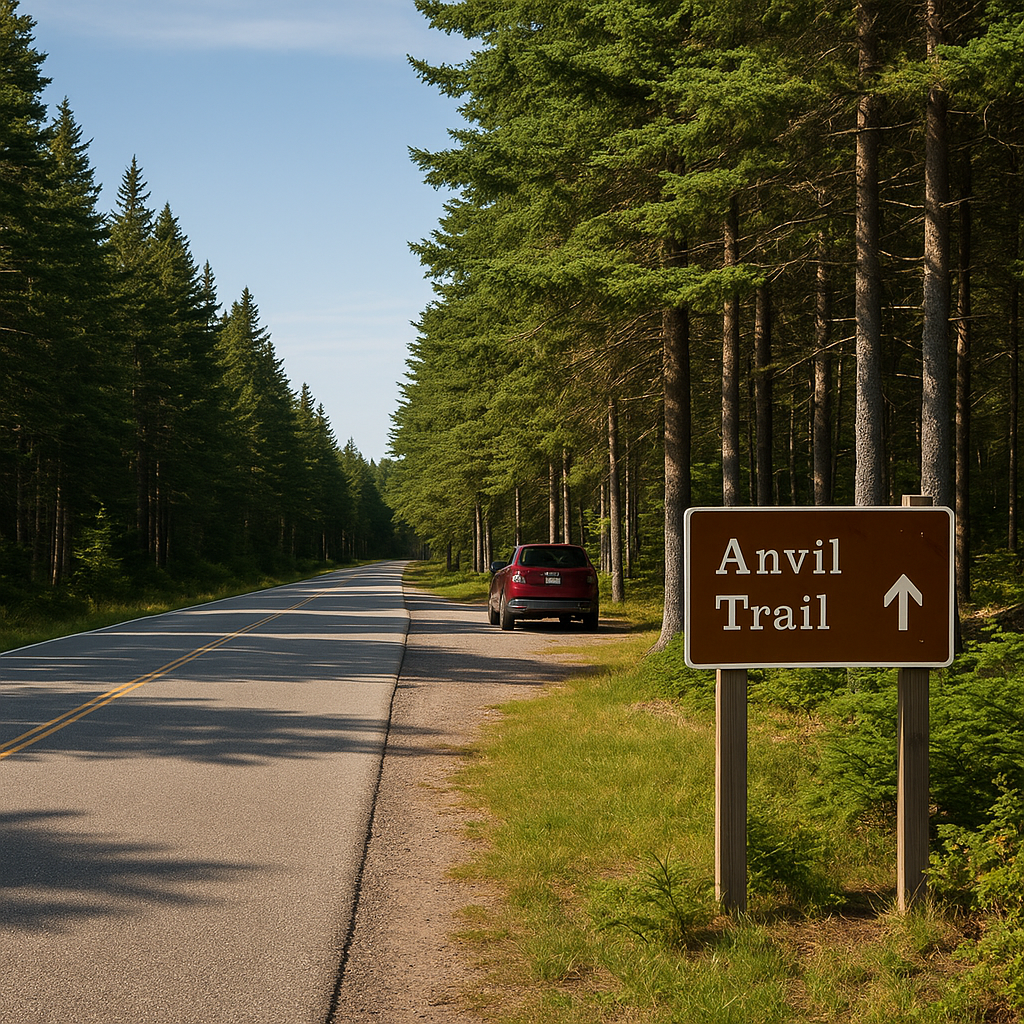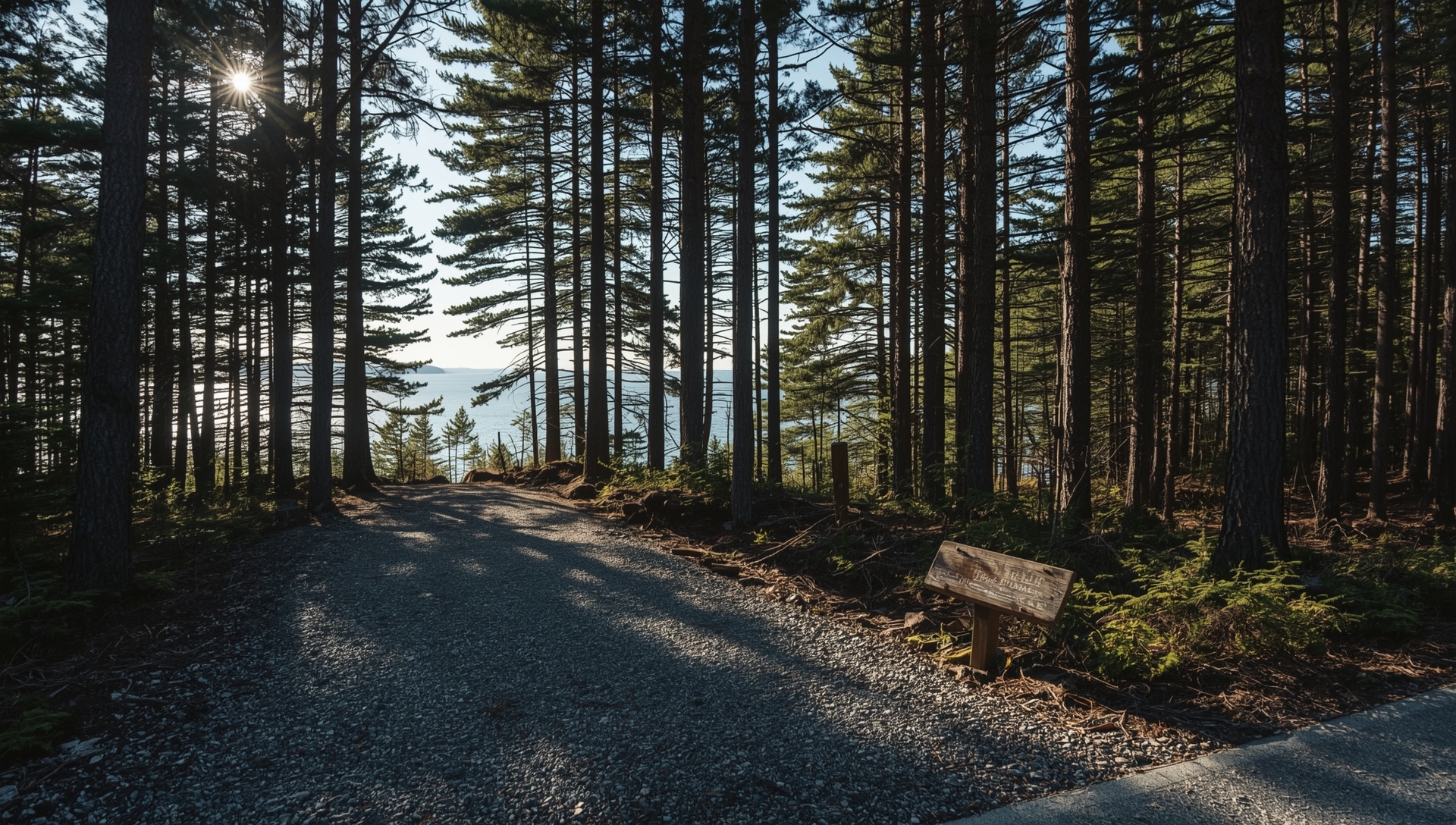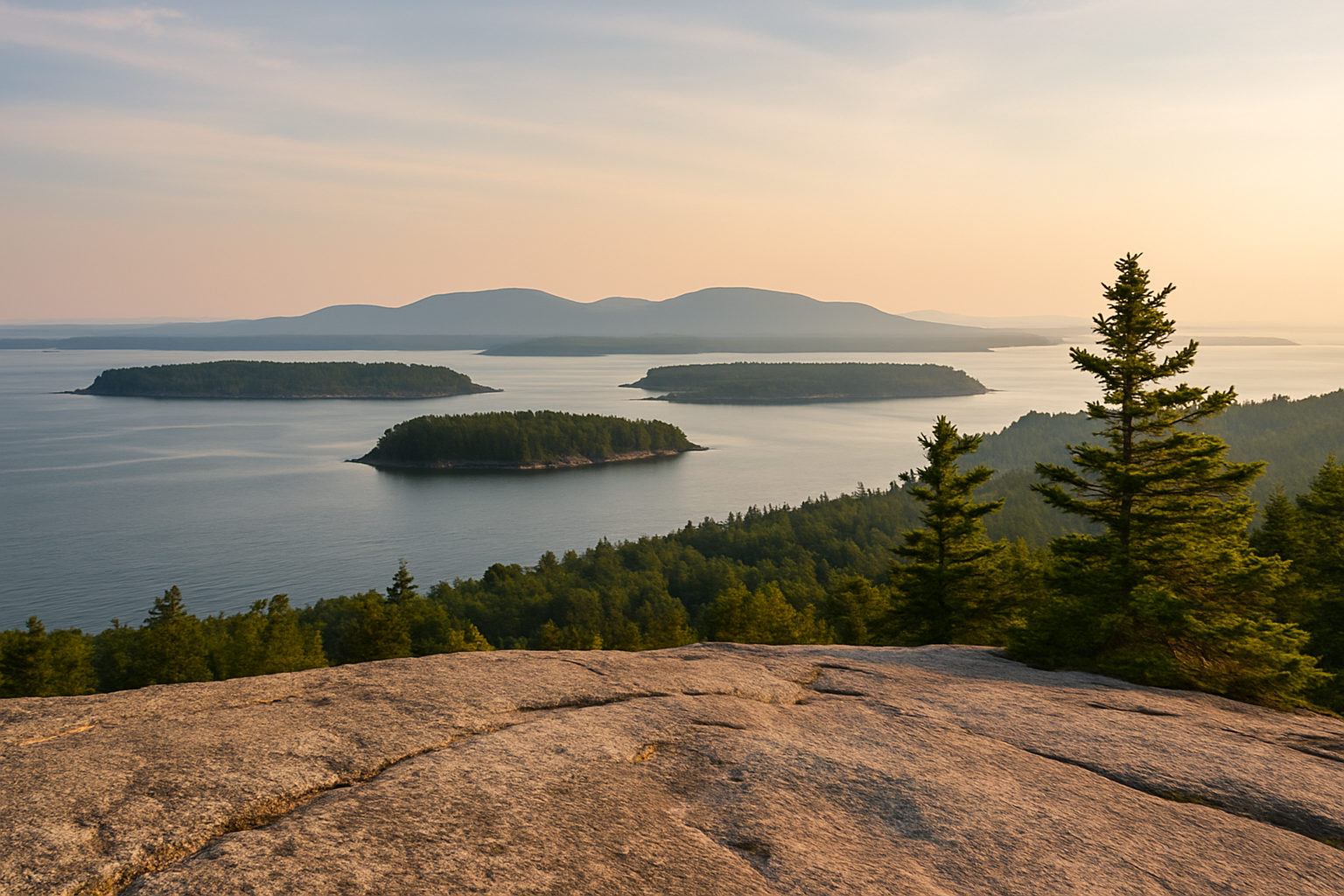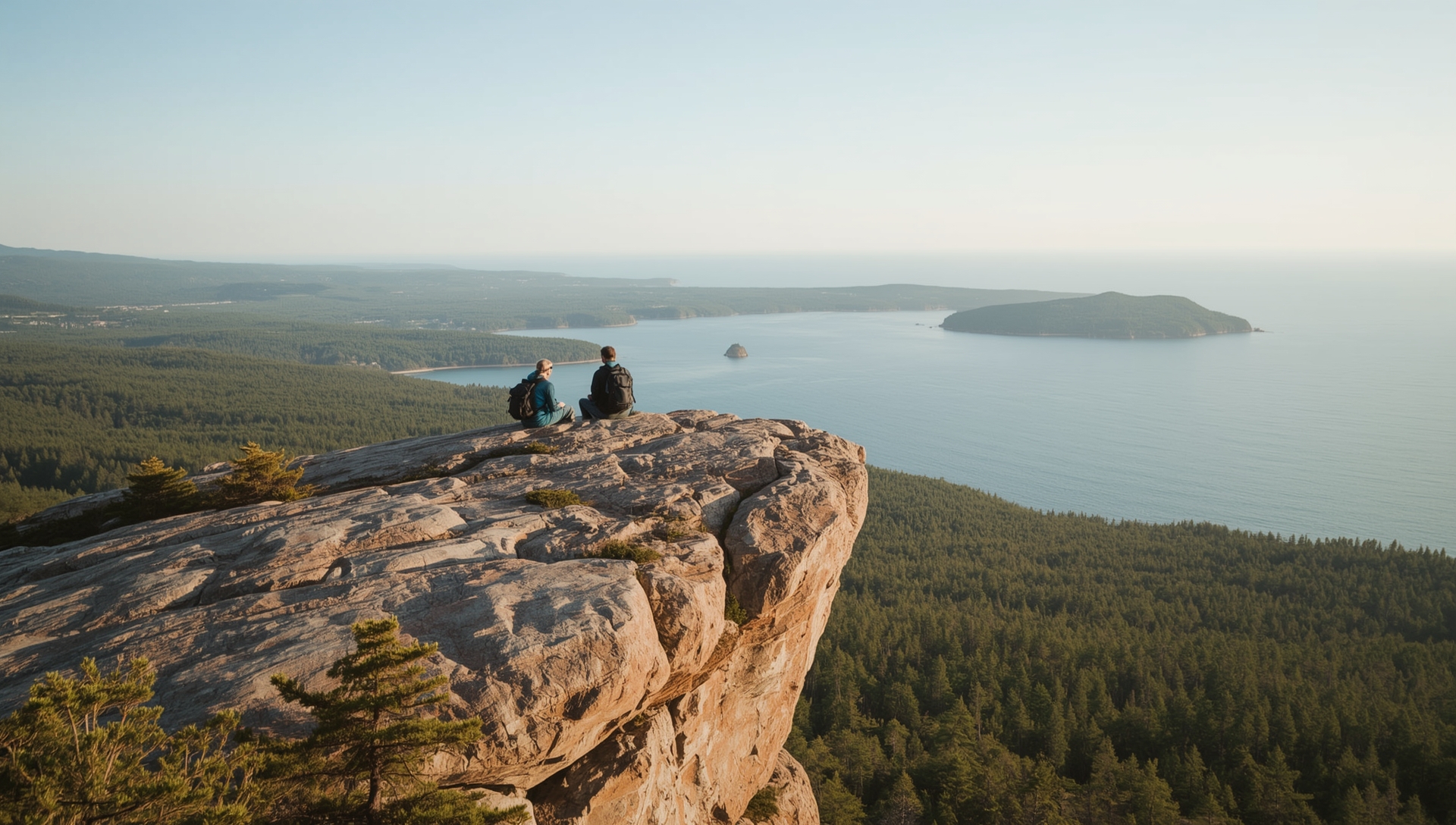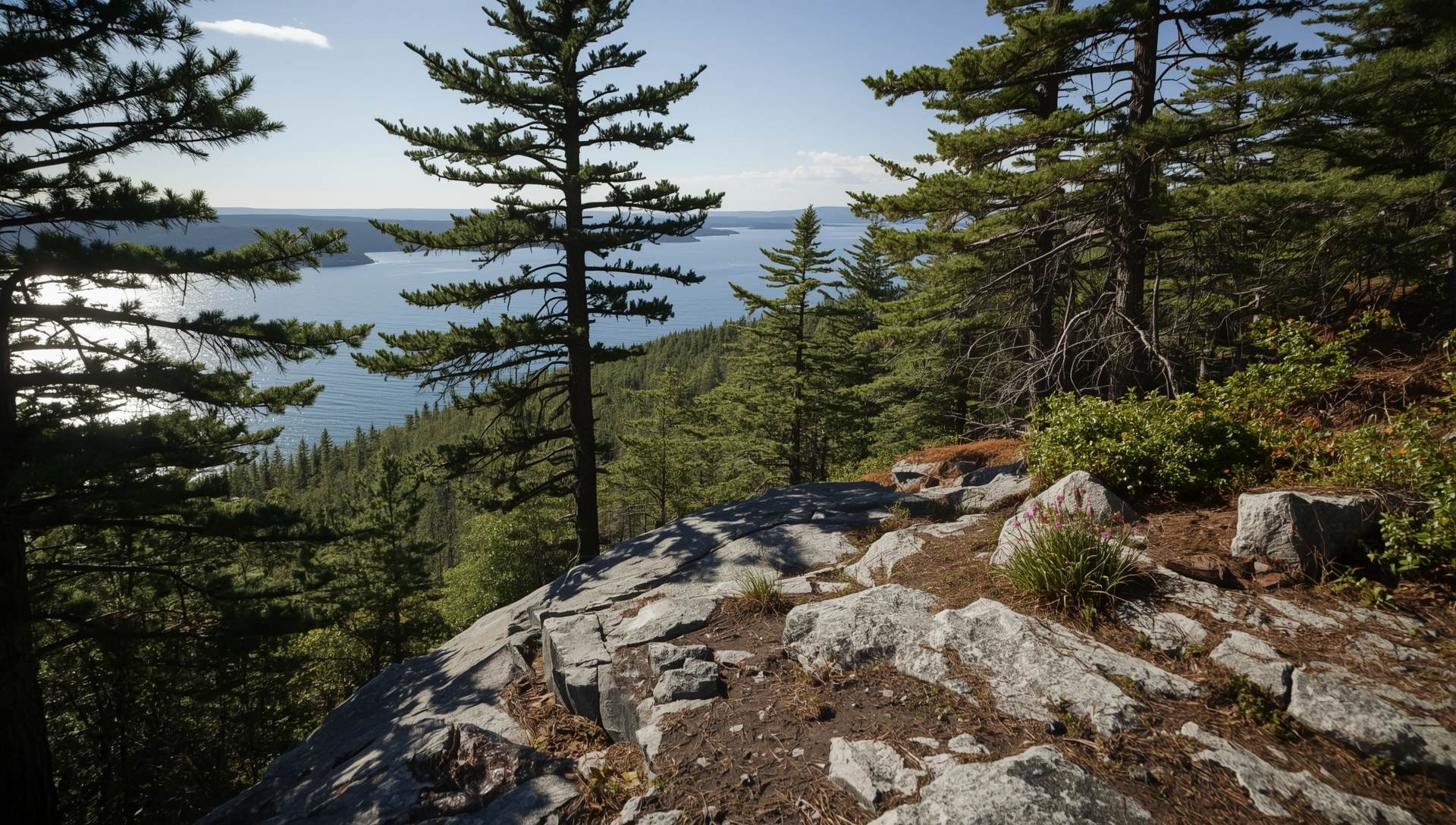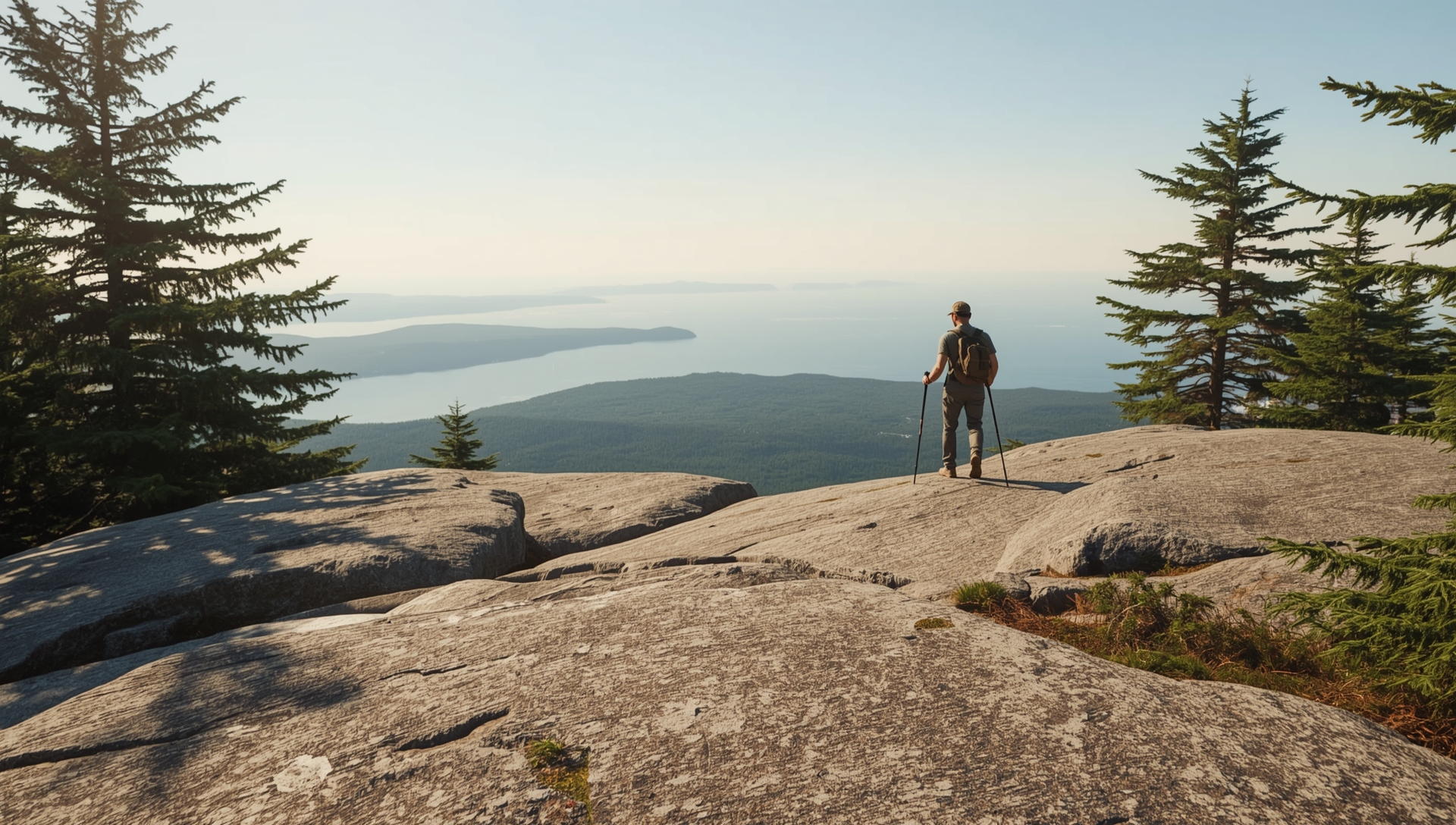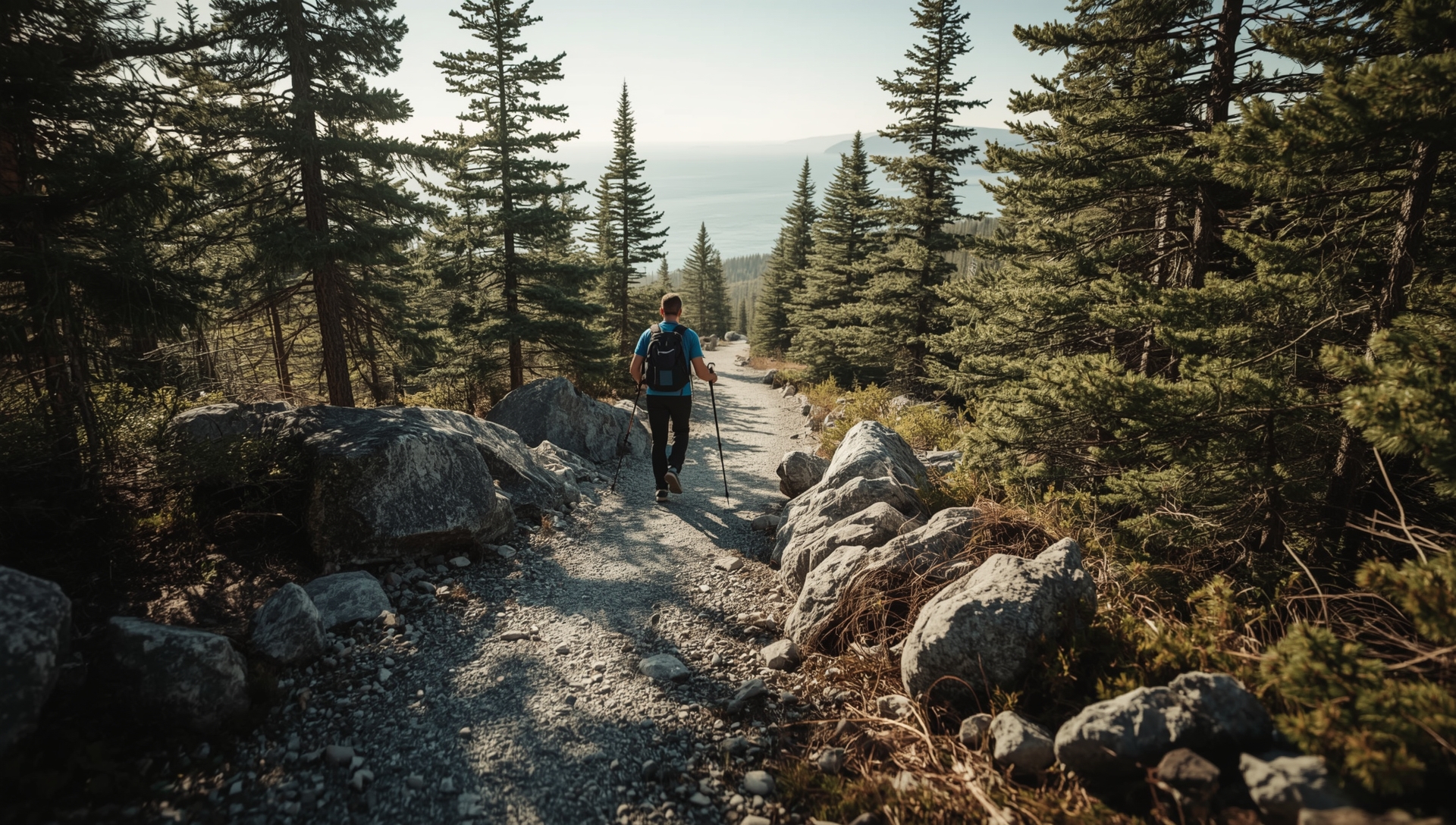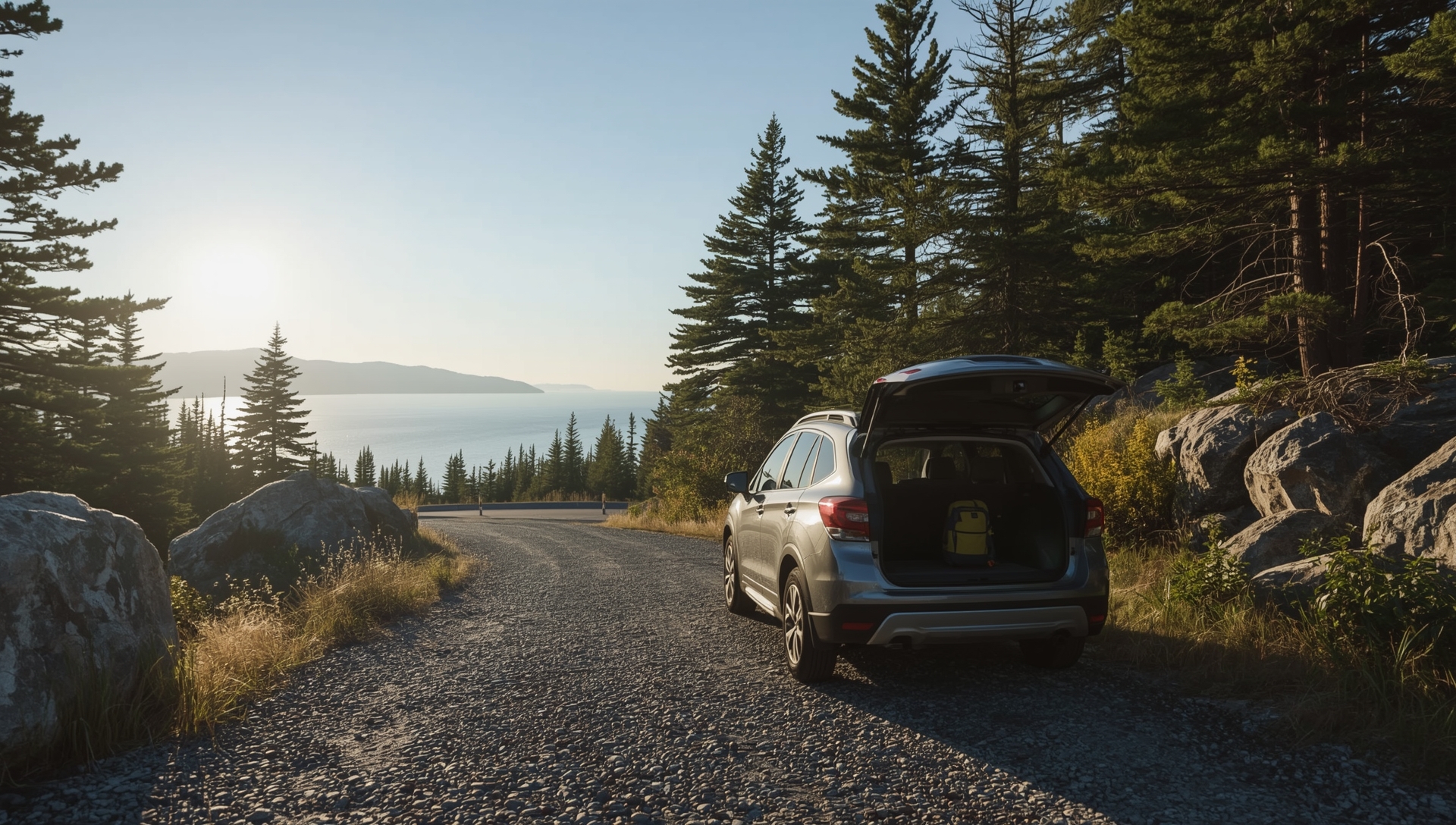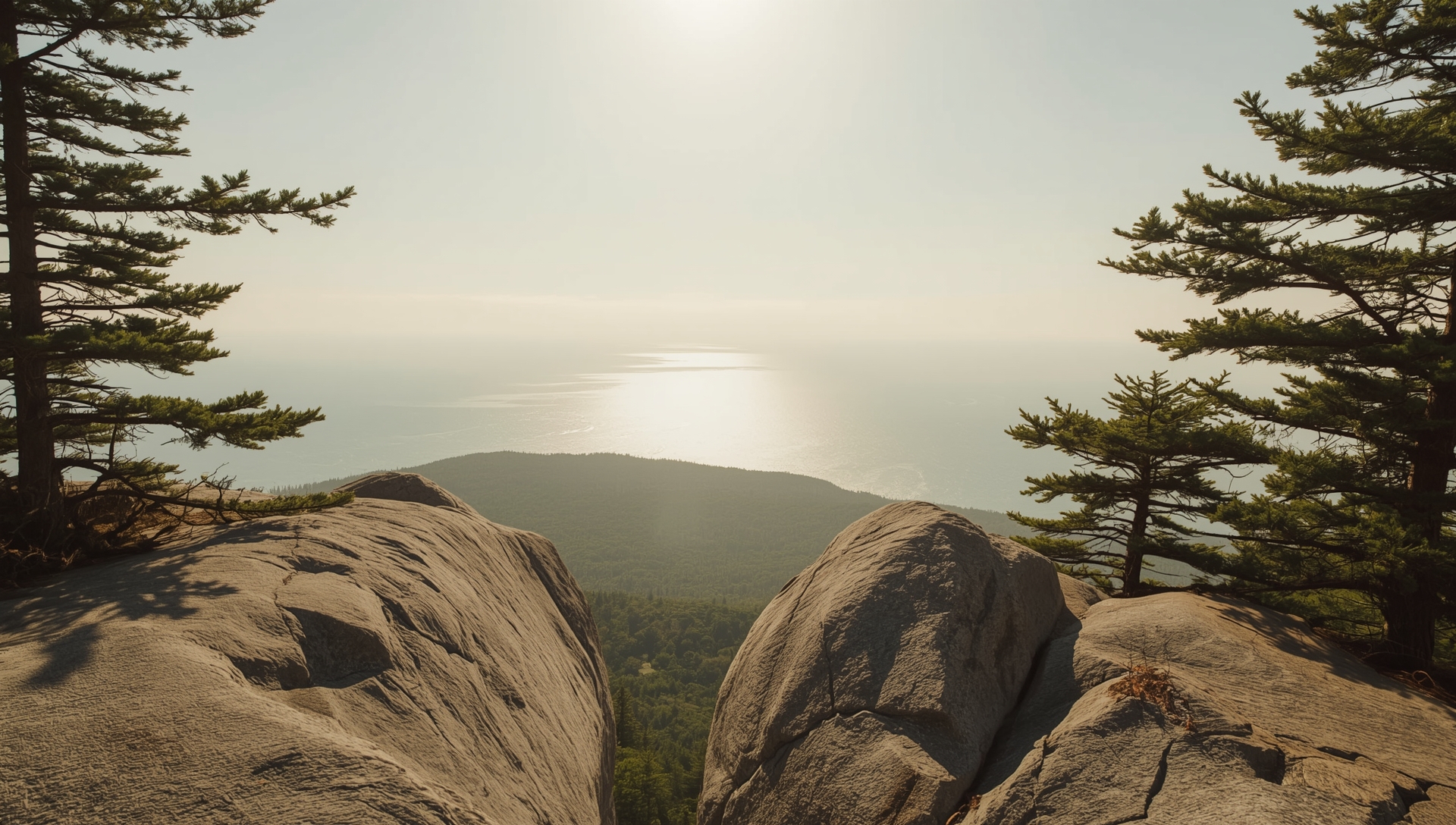Anvil Trail Schoodic
Discover the Beauty and Solitude of Anvil Trail, Schoodic Peninsula
The Anvil Trail Schoodic is one of those hikes that feels both intimate and grand at the same time — a short, steady climb that rewards every step with solitude, scent, and sweeping views. Beginning beneath a cool canopy of spruce and fir, the trail meanders through a lush, shaded forest where the ground is soft with moss and needles, and the air carries the faint tang of salt drifting inland from the nearby ocean. The path twists and rises gently, threading between granite outcrops and carpets of lichen, the kind of details that make the Schoodic Peninsula feel untouched and timeless.
As the climb continues, the trees begin to thin and the horizon opens. Broad slabs of granite catch the light, revealing the trail’s namesake outcrop — a natural rock ledge shaped like an anvil, balanced high above the bay. From this vantage point, the reward is spectacular: a panorama stretching across Frenchman Bay, dotted with islands, fishing boats, and the distant ridges of Mount Desert Island and Cadillac Mountain shimmering on the horizon.
Though the Anvil Trail is relatively short compared to Acadia’s mountain routes, its atmosphere feels wilder and more personal. The steady rhythm from forest floor to open ledge mirrors the peninsula’s unique blend of quiet and drama. At sunrise or late afternoon, when the granite glows pink and gold, photographers and nature lovers alike will find this spot unforgettable.
For those exploring the Schoodic Peninsula, this trail pairs beautifully with nearby routes like Schoodic Head, Alder Trail, and Lower Harbor Trail. Whether you’re seeking a peaceful escape, an inspiring viewpoint, or a connection to Acadia’s quieter side, the Anvil Trail Schoodic offers the perfect mix of challenge, reflection, and natural beauty.
• Trail length: ~1.2 miles round trip
• Terrain: Moderate climb through spruce–fir forest to granite ledges
• Views: Panoramic outlooks across Frenchman Bay and Mount Desert Island
• Connections: Part of the Schoodic Head Trail network
• Atmosphere: Often less crowded than Mount Desert Island hikes
• Best for: Sunrise or late-afternoon photography
• Nearby trails: Alder Trail, Blueberry Hill, and Schoodic Head
Anvil Trail Schoodic - Highlights
The Anvil Trail Schoodic may be modest in length, but it delivers an experience far bigger than its mileage suggests. Every stage of the hike reveals something new — from cool, shaded forest to open granite ledges with sweeping ocean views. What makes this trail so special is how effortlessly it blends challenge, scenery, and stillness into one unforgettable loop of coastal Acadia.
- Length & Difficulty
The Anvil Trail Schoodic offers the ideal balance between accessibility and reward. Stretching just over a mile one way, it’s short enough to fit into a relaxed morning or afternoon but long enough to feel like a genuine hike. The trail begins gently, rising through soft forest duff before shifting to stone steps and rocky footing. Roots, slick ledges, and patches of exposed granite add texture underfoot, reminding you that this is still Acadia — wild, raw, and wonderfully real.
Though the climb is steady, it’s rarely strenuous. Most hikers describe it as moderate in difficulty — a comfortable challenge without the need for poles or scrambling. It’s perfect for families with older children who can handle uneven terrain, couples seeking a short adventure with big views, or experienced hikers looking for a low-commitment trail that still delivers a payoff. The total elevation gain is modest, but the steady ascent gives your legs just enough burn to make the view from the top feel earned.
- Scenery
For such a compact route, the scenery changes quickly and dramatically. The lower section threads through a shaded spruce–fir forest, where the scent of needles mixes with the salty tang of the nearby sea. Moss cushions the rocks, and shafts of sunlight filter through the canopy, lighting up tiny ferns along the path. As you ascend, the trees begin to thin, the air brightens, and the first granite openings appear — pale, weather-smoothed ledges that reveal flashes of Frenchman Bay through the trees.
Soon, the trail leads to the Anvil itself, a broad granite outcrop that feels like nature’s balcony. From here, the view sweeps wide across the bay: islands scattered like stepping stones, lobster boats carving silver wakes, and the distant spine of Mount Desert Island shimmering on the horizon. On calm days, the ocean looks almost mirrored; on windy afternoons, you can see streaks of foam tracing the tide. Every visit feels different depending on the light, the season, and even the time of day.
- Atmosphere
What truly defines Anvil Trail Schoodic isn’t its elevation or length — it’s its mood. Compared to the crowds of Mount Desert Island, Schoodic feels personal and unhurried. The forest muffles sound, the sea breeze drifts softly through the trees, and even at the overlooks there’s often just the quiet hum of wind and gulls. It’s a trail that invites you to pause — to linger on the granite ledges, watch shadows move across the bay, and breathe in the rhythm of the coast.
For many visitors, that sense of stillness is the real treasure here. Anvil Trail Schoodic reminds you that adventure doesn’t always need to be epic. Sometimes it’s simply about finding a quiet place between forest and sea, where you can look out across Frenchman Bay and feel completely at peace.
• Length: Just over 1 mile one way (moderate difficulty)
• Terrain: Forest path, rocky footing, and open granite ledges
• Scenery: Spruce–fir forest, mossy ground, and Frenchman Bay views
• Best for: Couples, families with older kids, and quiet explorers
• Rewards: Panoramic lookouts and solitude away from the crowds
• Connections: Links with Schoodic Head Trail and Alder Trail Acadia National Park loops
• Ideal times: Morning light or late-afternoon golden hour
• Nearby points: Blueberry Hill, Schoodic Loop Road, and Schoodic Point
Getting to Anvil Trail Schoodic
Reaching the Anvil Trail Schoodic is a journey that mirrors the character of the hike itself — calm, scenic, and quietly immersive. The drive along the Schoodic Loop Road is one of the most peaceful experiences in Acadia National Park, winding through forest, coastline, and open sky. From the small village of Winter Harbor, the road curves gently through stands of spruce and fir, revealing glimpses of rocky shoreline, tidal inlets, and coves where waves lap quietly at the granite. The air feels cooler here, tinged with salt and pine, and even before you reach the trailhead, you’ll sense the shift away from the busier rhythm of Mount Desert Island.
The Anvil Trailhead lies just a few miles beyond Winter Harbor, on the inland stretch of the Schoodic Loop Road. It’s marked by a small, brown National Park Service sign tucked along the right-hand shoulder — simple, unassuming, and easy to miss if you’re not watching for it. The roadside pull-off beside it holds only a handful of cars, framed by low spruce and patches of moss. The setting feels almost hidden, a reminder that this is Acadia’s quieter side. Most hikers spend less than two hours on the trail, so parking usually turns over quickly. Even in summer, the lot rarely feels crowded, allowing the trail’s serenity to remain intact.
Stepping out of your vehicle, the sounds of the peninsula take over — wind whispering through the trees, the occasional caw of a gull, and the faint crash of waves beyond the forest. The trailhead sign stands at the edge of a shaded path, welcoming you into a world where the only traffic is the rustle of branches. There are no restrooms, no kiosks, and no commercial distractions — just a short, natural trail waiting to be explored.
For those planning a full day on the Schoodic Peninsula, the Anvil Trail fits seamlessly into a scenic circuit. Begin at Frazer Point, a grassy picnic area with tidal views and ocean breezes. Continue to Anvil for a satisfying mid-morning hike, then drive a few minutes farther to tackle the Schoodic Head Trail, which offers higher elevation and sweeping panoramas of Frenchman Bay. To end the day, stop at Schoodic Point, where the Atlantic roars against pink granite ledges in a spectacle of sea spray and sound.
Whether approaching from Winter Harbor or looping in from Birch Harbor, getting to the Anvil Trail is simple yet deeply rewarding. The journey itself — slow, scenic, and unhurried — feels like a quiet invitation into the heart of Acadia’s wild, coastal beauty.
• Located along the Schoodic Loop Road near Winter Harbor, Maine
• Small roadside pull-off with brown National Park Service trail sign
• Trailhead nestled in spruce and fir forest, minutes from Frazer Point
• Scenic approach drive featuring coves, inlets, and ocean views
• Nearby hikes: Schoodic Head Trail, Alder Trail, and Lower Harbor Trail
• Best visited as part of a day exploring the Schoodic Peninsula
• Limited parking maintains the quiet, uncrowded feel year-round
What You’ll See
Walking the Anvil Trail Schoodic is like watching Acadia unfold from shade to horizon. The opening steps slip beneath a canopy of spruce and fir where daylight filters green and gold, and the forest floor glows with moss, needles, and fern. Roots braid across the path; flecks of granite flash where soil thins. The air smells of pine resin edged with salt from Frenchman Bay. Birdsong stitches the quiet—warblers high in the crowns, chickadees close at hand, and, now and then, the coarse call of a raven from deeper woods. It feels enclosed in the best way, a calm corridor that settles your pace and sharpens your senses.
Climbing brings change. The trunks stand wider apart, slivers of sky appear between boughs, and warmth begins to touch the trail. Soil yields to stone—pink-gray granite veined with quartz, stippled with pale lichen, crosshatched by hairline cracks that cradle tiny tufts of grass. The fragrance shifts from damp needles to a briny breeze. Through branches the bay starts to shine: first a glimmer, then a pane of blue, then the delicate shapes of islands set like brushstrokes on water. Sound widens too; along with wind in the trees you catch a gull’s cry and the faint wash of swell on distant rock.
Higher still, the trees fall back and ledges broaden. The path resolves at its namesake, an anvil-shaped outcrop that projects gently above spruce crowns like a natural balcony. Step onto the rock and the view arrives all at once. Frenchman Bay stretches away in layered blues; forested islets scatter toward the horizon; and, on clear days, the ridgeline of Mount Desert Island draws a fine, precise line across the sky. Morning lays silver on the sea. Late light warms the granite to honey and draws long shadows that edge the ledges with definition. On quiet afternoons you might trace the wake of a lobster boat cutting a pale thread across the water; on brisk days you’ll watch gusts darken the surface and send gulls tilting on invisible currents.
What you’ll see here is Schoodic distilled: forest yielding to rock, rock leaning toward ocean, ocean dissolving into sky. The drama is understated and exact, more invitation than performance. Pause and look small before you look far—the sparkle of mica, the peppering of reindeer lichen, the pale cushion of moss at the rim of a fissure, a knot of bayberry gripping shallow soil. Then lift your eyes and let the space do its work. The Anvil Trail Schoodic offers perspective more than conquest, presence more than pace. You arrive, you stand, you breathe, and the peninsula gathers itself into a single, quiet moment that lingers long after you’ve stepped back beneath the trees.
Tips for Hiking
Hiking the Anvil Trail Schoodic is straightforward but full of small details that make preparation worthwhile.
The terrain changes quickly — shaded forest floor one moment, sunlit granite the next — and the weather near the bay can shift just as fast. A few simple choices about when to go, what to wear, and how to tread can turn a good hike into an unforgettable one.
- Footwear and Gear
The surface of the Anvil Trail Schoodic changes quickly and often. In the lower forest, the path is soft underfoot — a mix of pine needles, dirt, and tree roots that weave across the ground like natural steps. Higher up, it transitions into the exposed granite ledges that give Schoodic its wild, open feel. Those ledges are beautiful but can be slick after rain or early morning dew, so sturdy footwear is essential. Choose hiking boots or trail shoes with good grip and ankle support; they’ll make the climb feel steady and safe. Carrying a small daypack is wise too — include water, a light snack, a windproof jacket, and your phone or camera for the summit view. Even in summer, the breezes at the overlook can feel cooler than expected.
If you’re visiting in spring or fall, a light pair of gloves and an extra layer make the top far more comfortable. Mosquitoes are present in early summer, so insect repellent helps if you’re hiking through shaded sections. The forest keeps the trail cool and pleasant, but remember that once you reach the ledges, there’s little shade — a hat and sunscreen are handy additions.
- Best Times to Go
Early morning is the magic hour on the Anvil Trail. The light filters through the trees, birds are active, and the bay glimmers through the gaps between branches. It’s calm, quiet, and often you’ll have the trail nearly to yourself. By late afternoon, the granite ledges turn golden and Frenchman Bay glows in warm light — perfect for photography. Just allow enough time to descend before the sun sets; the forest floor darkens fast. Midday is busier but never overcrowded, and even then, Schoodic’s atmosphere remains peaceful compared to the bustle of Mount Desert Island.
- Trail Etiquette
Respect the trail’s natural quiet. Step on durable surfaces when crossing ledges to avoid damaging lichens or fragile plants. Yield to uphill hikers on narrow sections, keep voices low, and pack out all trash, including small wrappers and tissues. Every step of care helps preserve the stillness and cleanliness that make this place feel timeless.
- Family-Friendly Advice
The Anvil Trail Schoodic suits families with school-aged children. The route is short enough to hold their attention yet full of small adventures — mossy clearings, rocks to scramble, and forest textures to explore. Supervise carefully near the overlook; the ledges are safe but open. Bring snacks, take photos, and turn the hike into a shared discovery — kids remember the view far longer than the climb.
• The granite on Schoodic Peninsula is part of the same ancient bedrock that forms Cadillac Mountain.
• Lichens on the ledges can take decades to grow — one footprint can damage years of progress.
• Frenchman Bay is home to harbor seals and porpoises often visible from Anvil’s overlook.
• The Schoodic Loop Road offers five scenic pull-offs within minutes of the Anvil Trail.
• Evening hikes here often end with the sound of bell buoys echoing across the bay.
Seasonal Notes
The Anvil Trail Schoodic is one of those rare places that feels entirely different depending on when you visit.
Each season reshapes the experience — the color of the light, the feel of the wind, even the sound of the forest.
In spring, the peninsula breathes back to life; in summer, it hums with energy; by autumn, it blazes with color; and in winter, it falls silent under snow. No matter when you go, the view from the granite ledge tells a new story about Acadia’s most peaceful corner — one of rhythm, renewal, and timeless beauty.
By midsummer, the Anvil Trail Schoodic feels full and lush. The spruce–fir forest deepens into darker shades, and the granite ledges warm under long daylight hours. The bay sparkles in full sun, and a steady sea breeze sweeps across the open rock. Morning fog often drifts in from the water, wrapping the trees in silver before the light breaks through. Lobster boats trace small wakes across Frenchman Bay, and gulls circle overhead. Shade in the lower forest keeps the climb comfortable, while the ledges glow pink against the blue horizon — pure summer on the Maine coast.
Autumn transforms the peninsula into one of the most colorful places in Acadia. The Anvil Trail Schoodic bursts into reds, golds, and oranges that cascade toward the water. Fallen leaves crunch beneath your boots, and crisp air sharpens every view. The overlook feels especially vivid — blue sea, gray granite, and a forest painted in flame. A drone from above would capture a quilt of color rolling down to Frenchman Bay. This is the season for photographers and anyone who loves the sound of dry leaves swirling across stone.
Winter reveals the Anvil Trail Schoodic at its quietest. Snow drapes the spruce branches, granite ledges frost white, and Frenchman Bay reflects a pale winter sun. The air is still, and the forest muffles sound to near silence. Ice forms along the trail, but with traction gear, the hike becomes a serene adventure. From the overlook, seals sometimes appear on offshore rocks, and seabirds glide low across the gray water. It’s stark, peaceful, and deeply beautiful — Acadia stripped to its essentials.
Spring brings freshness and life to the Anvil Trail Schoodic. The forest canopy brightens to pale green as buds unfurl, and sunlight filters gently through new leaves. On the trail, wildflowers like bunchberry and violets edge the mossy path, while damp earth releases a clean, woody scent. The air is cool and clear, ideal for hiking without crowds. Frenchman Bay shimmers blue beyond the trees, and birdsong fills the forest — warblers, sparrows, and the returning song of the white-throated sparrow carrying from the treetops. Everything feels new again.
• Spring on Anvil Trail brings wildflowers and returning songbirds
• Summer offers long days, lobster boats, and ocean breezes
• Fall colors paint Schoodic in reds, golds, and amber light
• Winter reveals frost-tipped granite and quiet, snowy forest
• Each season offers a unique way to see Frenchman Bay’s changing moods
Wildlife & Nature
One of the true pleasures of hiking the Anvil Trail Schoodic is how alive the landscape feels. Every step reveals evidence of the wildlife that quietly thrives in this lesser-traveled corner of Acadia. In the cool, shaded forest, the soundtrack is constant — the chatter of red squirrels, the fluting notes of warblers, and the soft rustle of small creatures moving through the moss. Look closely along the trail and you’ll see where deer have passed or where a chipmunk has left tiny prints in the damp soil. During spring and summer, the forest becomes a haven for migratory birds returning north, and patient hikers can sometimes spot nuthatches creeping along the bark of old spruce trees or chickadees darting between branches.
As the trail begins to climb, the environment subtly changes. The canopy thins, the air sharpens with salt, and the sounds of the forest blend with the wind and the sea. Here, the wildlife shifts too. Seabirds take over the skies — gulls gliding on invisible thermals, double-crested cormorants flying in formation over Frenchman Bay, and the distinctive, heavy-winged silhouette of a bald eagle cruising above the forest line. The granite ledges offer perfect vantage points for scanning the bay below, where common eiders and black guillemots often gather in the calmer waters. On some days, an osprey may appear, hovering momentarily before plunging down in a splash of white to seize a fish — a powerful reminder that the entire ecosystem here is bound to the sea.
The plant life along Anvil Trail is just as fascinating and every bit as resilient. Hardy lichens and mosses creep across the granite, their slow, steady work turning rock to soil over decades. Blueberry bushes grow low and tough near the trail edges, offering bursts of red in autumn when their leaves change color. Higher up, spruce and fir dominate the canopy, their needles perfuming the air with the clean scent of resin. In spring, the forest floor glows with patches of bunchberry, and by late summer, the mix of greenery and exposed granite creates a mosaic of texture unique to Schoodic.
Together, the combination of forest, ledges, and ocean creates a natural mosaic that captures Acadia’s true diversity. The Anvil Trail Schoodic isn’t just a route to a viewpoint — it’s an encounter with a living landscape. Every sound, scent, and movement adds to a sense of connection that lingers long after you’ve left the overlook.
• Chickadees, nuthatches, and warblers fill the forest with song in spring and summer
• Gulls, cormorants, and eiders are often seen over Frenchman Bay
• Bald eagles and ospreys hunt the coastal waters near the overlook
• Lichens, mosses, and low blueberry shrubs thrive on granite ledges
• Spruce and fir scent the air, adding to Schoodic’s wild coastal atmosphere
Accessibility
Anvil Trail Schoodic is considered moderate in difficulty, though its accessibility depends heavily on comfort with natural surfaces, uneven footing, and gradual elevation. The trail begins in a shaded spruce–fir forest, where the path narrows between roots and rocks. For many, this first section feels welcoming and peaceful, but hikers with limited mobility or balance concerns will notice the irregular surface early on. The air is cool, the ground soft, and the forest alive with the scent of pine and moss — a beautiful setting, though not designed for assisted access.
As the trail climbs, the incline becomes more noticeable, yet never steep enough to feel daunting. The main challenge lies in the terrain itself: granite ledges, loose stones, and patches of exposed roots that require careful footing. There are no railings, constructed steps, or paved sections along this route. Acadia National Park keeps its trails intentionally rugged, offering visitors an authentic wilderness experience. Supportive hiking boots are essential, and trekking poles can greatly enhance balance on the rocky ascent and descent.
Midway through, the trees begin to thin, opening toward the ledges that define the Anvil Trail’s finale. The overlook is a broad, stable granite outcrop, offering panoramic views across Frenchman Bay. However, drop-offs are unguarded, and those with vertigo or a fear of heights may prefer to stay back from the edges. Families should keep a close eye on children near open sections, where granite slopes can be slick after rain.
The descent can feel more demanding than the climb. Careful steps are needed on the uneven rock, especially for older hikers or anyone with knee or ankle sensitivities. This is not a trail for strollers, wheelchairs, or mobility aids, and there are no accessible parking spaces at the trailhead — only informal roadside pull-offs. Visitors seeking accessible alternatives can still enjoy the Schoodic Peninsula from locations such as Frazer Point, where tidal views, picnic tables, and flat paths offer easy enjoyment of the landscape.
Ultimately, the Anvil Trail Schoodic rewards those who are prepared. With good shoes, steady pacing, and a bit of patience, it’s an attainable and memorable hike that combines a touch of challenge with profound peace. The granite ledges, ocean breezes, and forest stillness make it an experience worth the effort — a true reflection of Acadia’s rugged charm.
• The Anvil Trail Schoodic is classified as moderate — ideal for hikers with good balance and proper footwear.
• There are no paved sections or handrails, preserving Acadia’s natural terrain.
• Visitors seeking accessible Acadia National Park experiences can explore Frazer Point for flat trails and picnic areas.
• Trekking poles and grippy shoes are recommended for safe footing on granite ledges overlooking Frenchman Bay.
Nearby Trails & Connections
Hiking the Anvil Trail Schoodic is rewarding in itself, but one of its best qualities is how seamlessly it fits into a full day of exploring the Schoodic Peninsula. This side of Acadia National Park is compact yet incredibly diverse, and its close-knit trail network means you can enjoy forest hikes, summit views, and dramatic coastline — all without retracing your steps or spending much time driving.
Just a few minutes up the Schoodic Loop Road, the Schoodic Head Trail offers an excellent follow-up to Anvil’s steady climb. Where the Anvil Trail leads to its namesake granite outcrop overlooking Frenchman Bay, Schoodic Head takes you slightly higher to a rounded summit with broader, 360° panoramas. From the top, you can see the islands of Frenchman Bay stretching toward Mount Desert Island — a perspective that pairs beautifully with Anvil’s more intimate overlook. Doing both trails in one outing offers a balance between effort and reward, giving you two distinct ways to experience Acadia’s landscape.
If you prefer something gentler between hikes, Frazer Point makes the ideal companion stop. Located near the beginning of the loop road, this quiet shoreline area features grassy picnic spaces, tidal pools, and easy walking paths shaded by spruce. It’s a favorite spot for families and photographers — a place to pause and reflect, with views of seabirds and lobster boats across calm water. Combining Frazer Point with Anvil Trail creates a well-rounded half-day that includes both forest and sea.
Further along the peninsula lies Schoodic Point, one of the park’s most dramatic locations. Here, wide ledges of pink granite plunge into the Atlantic, and the rhythm of crashing surf fills the air. Standing here at sunset — especially after hiking Anvil earlier in the day — creates a sense of completeness that few parts of Acadia can match. The entire loop drive itself becomes part of the experience, linking viewpoints, trailheads, and ocean vistas into one continuous journey.
Taken together, these routes — Anvil Trail, Schoodic Head, Frazer Point, and Schoodic Point — form a natural circuit around the Schoodic Peninsula. Each stop reveals a different personality: peaceful forest, expansive summit, quiet shoreline, and roaring coastline. For hikers and sightseers alike, they’re a reminder of why Schoodic is often called Acadia’s best-kept secret — a place where every turn offers something new, without ever feeling crowded.
• Hike the Schoodic Head Trail for a higher summit view across Frenchman Bay.
• Stop at Frazer Point for picnic areas and tidal exploration.
• End your day at Schoodic Point to watch the Atlantic surf crash against pink granite.
• All trails connect via the Schoodic Loop Road, making it easy to experience forest, summit, and sea in one visit.
Wrapping Up
Hiking Anvil Trail Schoodic is proof that big rewards don’t always require long distances. In little more than a mile, this modest trail captures the essence of Acadia’s quieter side — shaded forest, rugged granite ledges, and sweeping views over Frenchman Bay. What makes it memorable isn’t just the scenery but the atmosphere: the sense of solitude, the salt-tinged air drifting up from the water, and the feeling that you’ve discovered a corner of the park reserved for those who take the time to look.
The overlook itself is the kind of place where hikers linger. Some sit quietly on the granite ledge, listening to seabirds wheel overhead; others take photos of the islands scattered like stepping stones across the bay. However you experience it, the Anvil Trail offers a moment of pause and perspective. It’s less about conquering distance and more about savoring a landscape shaped by sea, forest, and stone.
For visitors with only a day on the Schoodic Peninsula, this trail pairs seamlessly with Schoodic Head, Frazer Point, and Schoodic Point. Together, they create a complete picture of what makes this corner of Acadia so special: variety, beauty, and a welcome absence of crowds. Whether you hike it in spring with wildflowers blooming, in autumn when the colors blaze, or in winter when silence rules the forest, the Anvil Trail is a reminder that sometimes the best parts of Acadia are found off the busiest paths.
• Distance: ~1.1 miles round trip, moderate difficulty
• Terrain: Forest paths, roots, and open granite ledges
• Highlight: Panoramic views over Frenchman Bay and Acadia’s coastline
• Best Times: Morning calm or late-afternoon golden light
• Nearby Trails: Schoodic Head, Frazer Point, and Schoodic Point
• Ideal For: Hikers seeking quiet views and Acadia’s rugged coastal character
• Wildlife: Chickadees, warblers, eiders, and bald eagles
• Location: Schoodic Peninsula, Acadia National Park, Maine
Big rewards from a short, scenic climb — the Anvil Trail captures the peaceful beauty of Acadia’s quieter side.
The Anvil Trail may be short, but its granite ledges and sweeping views over Frenchman Bay make it unforgettable. It’s a hike that perfectly captures the rugged spirit of the Schoodic Peninsula in just a mile. May it be one of many adventures that keep drawing you back to Acadia.
Explore the Schoodic Peninsula
• National Park Service – Schoodic Peninsula (Official)
• Friends of Acadia – Trail Support & Conservation
• Maine Trail Finder – Schoodic Head & Anvil Trails
Want more hiking tips and hidden gems across Acadia? Join our free newsletter and get insider advice delivered straight to your inbox.
Sign Up
